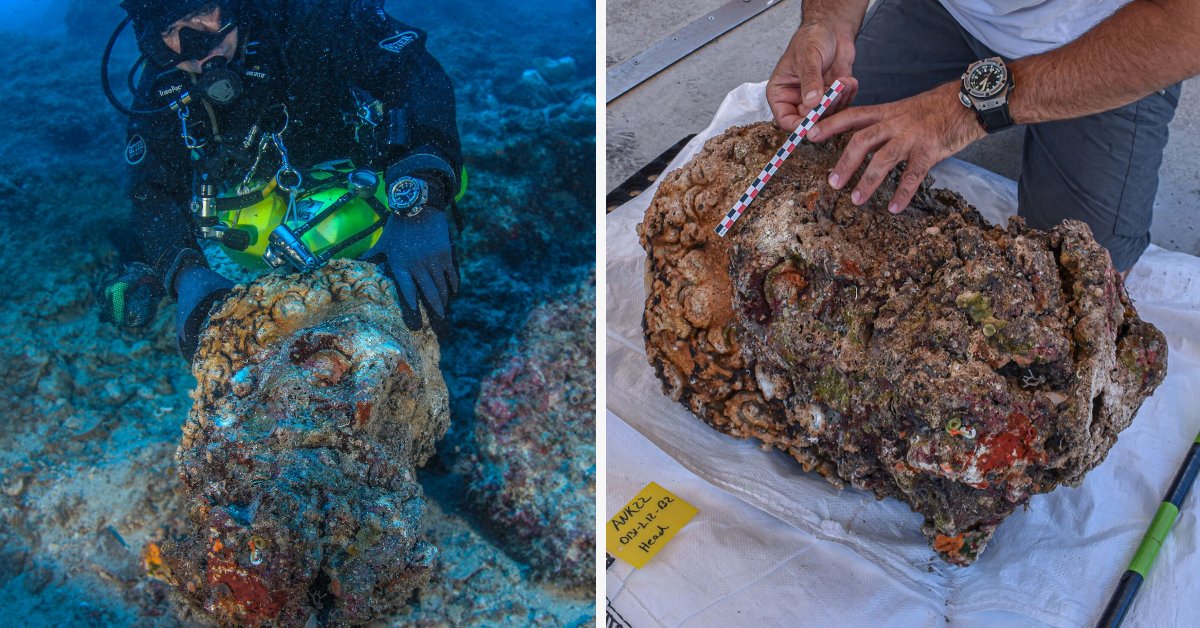Just off the rocky coastline of Greece, divers have discovered a treasure trove of artifacts at the site of the famous Antikythera shipwreck. Among the many astounding finds is a marble head of Hercules, the famously strong divine hero from ancient Greek and Roman mythology.

While exploring the sea floor off the Greek island of Antikythera in 1900, a sponge diver stumbled upon the massive wreck of an ancient Greek vessel and the appalling remains of its crew. Shocked by the discovery, the man got back to the surface and told his captain, who at first thought that the nitrogen in the diver’s tank had simply caused him to hallucinate. But when he dove down himself to examine, he came back up with a bronze arm from one of the wreck’s dozens of statues.
In the 120 years since, unimaginable treasures have been found aboard the “Antikythera shipwreck,” from marble statues and countless coins and pieces of pottery, to a bronze lyre and a terrifying weapon known as the “dolphin,” an enormous lead bulb outfitted with an iron spike to rip through enemy vessels. The “Antikythera mechanism”, a device thought to be the world’s oldest known analog computer, was also found on board. And now, a 2,000-year-old marble head from a statue of Hercules was discovered in a previously hidden section of the wreck.

The discovery just announced was made during an “extremely successful” expedition that started with the removal of a large rock, allowing access to the previously unexplored part of the shipwreck.
Within this new cavity, they discovered the plinth of a marble statue featuring the lower parts of the legs, caked in a thick layer of marine deposits (pictured above). More interestingly, the marble statue head of a bearded man suspected to be Herakles (also known as the Roman Hercules) was also find here. It most probably belongs to the headless statue of the so-called “Herakles of Antikythera”, which was retrieved by sponge divers in 1900 and is now on display at the National Archaeological Museum of Greece.

Two human teeth embedded into the marine deposits that have appeared on the shipwreck over the millennia were also discovered. This is rather exciting as genetic and isotopic analysis of the teeth might shed some more light on the people who sailed this ship some 2,000 years ago.
Through studying the newly found objects, the team hopes to gain some understanding of the ship’s doomed voyage. So far, we only know that the 40-meter-long (130-foot) vessel was probably traveling from the Eastern Mediterranean toward Rome, and it apparently sank after a storm sent it crashing into the rocks off the coast of Antikythera.

Of all the objects found on the wreck, the Antikythera mechanism is definitely the most intriguing. Using a series of bronze gears, the device could predict eclipses, track the movements of the Sun, Moon, and stars, as well as the positions of the five planets the ancient Greeks knew: Mercury, Venus, Mars, Jupiter, and Saturn.
Why this incredible object was on the ill-fated ship remains a mystery, however.

Despite the wealth and diversity of artifacts found on the Antikythera shipwreck, the site has remained largely unexplored, partly due to its location and the characteristics of the seafloor on which it rests. The place is too deep for SCUBA divers, yet too shallow for a human-occupied submersible or a remotely operated vehicle (ROV).
So, recent efforts to explore the site involved divers using rebreathers to extend their time at the bottom and significantly reduce the need for decompression stops on the way back up. This time, researchers used a customized setup consisting of durable rigging, underwater lifting bags and pressurized air supply.

The incredible artifacts recovered from the Antikythera shipwreck make it one of the most significant finds in modern archaeology. The Antikythera Mechanism alone has changed our views of the limits of ancient technology, as it predates anything else on its level of sophistication by more than a thousand years. And there’s a lot more to be discovered at this fascinating site.
Sources: 1, 2, 3, 4, 5
